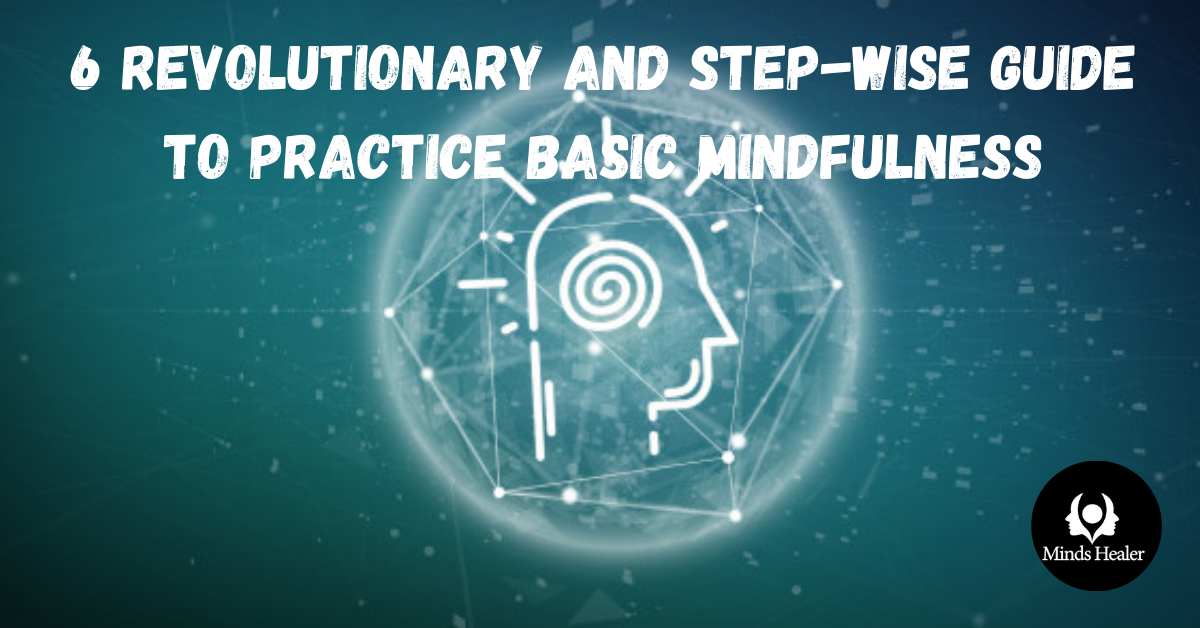
“In chaos, they found calm,
In disorder, found order,
Looking within, they found themselves.”
Now, you must be wondering who exactly are these ‘they’ that the verse talks about? Are they even real? This idea of being calm and orderly amidst the chaos that the world has today seems almost impossible. But is it really that far-fetched? In this rush of earning a living, are we really living? That is the reason why we need these 6 Revolutionary and Step-wise guide to practice basic Mindfulness
Many times while surfing through various social media platforms we come across quotes like, “Live in the present” but how? The answer to this question is just one word – Mindfulness. Mindfulness is a psychological state that involves awareness of the present. This practice of mindfulness helps to focus, acknowledge, and accept one’s feelings, thoughts, experiences, and sensations in a nonjudgmental way. Mindfulness is a natural attribute that we all have if we take time to savor and appreciate it.
Originally a Buddhist concept founded approximately 2600 years ago, mindfulness has distinctly shifted to prevailing practice in psychotherapy, especially along with cognitive-behavioral therapy (CBT).
Mindfulness helps us to:
- Be attentive – We often get so caught up in the daily routine of our fast-moving life that it becomes difficult to take a time-out. Mindfulness helps us to experience and enjoy our environment.
- Be present – Being present does not just mean being physically there, to live in the present is to stop worrying about the past and the future and just totally be in the present moment – physically, mentally, wholeheartedly.
- Accept oneself – There is a great emphasis in this approach on a non-judgmental practice which paves a strong foundation for self-love and accepting oneself.
- Prioritize oneself – Mindfulness helps create a space for ourselves where we can be away from the rat-race of our lives and just take time to think, breathe, and be connected to our true self.
HOW TO PRACTICE MINDFULNESS?
There are several – formal and informal – ways to practice mindfulness. You can cultivate mindfulness through yoga, meditation, and other practices. However, there is a lot of literature focusing on mindfulness fostered through meditation where one is trained to bring mental processes under greater voluntary control. This shall lead to greater mental well-being, calmness, concentration, and ability to let go of negativity (Walsh & Shapiro, 2006). Mindfulness meditation often involves –
- Practice of breathing
- Visualization and mental imagery
- Body and mind awareness
- Relaxation
6 Revolutionary and Step-wise guide to practice basic Mindfulness
- Determine a time – It need not be the same time each day but throughout the day try to set aside some time for mindfulness meditation. Though it is important to practice it daily, do not get worked up if it is not possible on some days.
- Be at ease – Spot at a place in your house or outside where it is quiet and you can sit calmly without being interrupted. The place can be anywhere you are at ease and comfortable. However, it is important to sit while meditating. You can sit on a chair or on the ground wherever your body is stable and not at strain so that you can be there for a while.
- Keep a timer – It would help if you keep a timer with a soft ring with you so that you can concentrate on meditating and forget about the time. The timer will allow you to keep track of time so that you are not meditating for longer than you wanted to.
- Concentrate on breathing – Soften your gaze, allow your eyelids to close. Bring each and every breath into your awareness. Feel as you inhale and exhale – how your nostrils flare as air goes in, how your belly and chest rises and fall, everything.
- Pay attention when your mind wanders – It is absolutely possible that your mind may wander elsewhere instead of paying attention to breathing. When you notice this, simply try to return your focus on breathing. It will need practice for refocusing yourself on the present moment of mindfulness.
- Be kind to yourself and forgive your wandering mind – Do not judge yourself or indulge in evaluating the thoughts that came in. Just return your awareness of breathing.
After you are done, slowly shift your gaze to your surrounding and get acquainted with the environment gradually. There are also applications that you can download to help you learn more about mindfulness meditation and guide you through this process.
Let us now practice this, for 1 minute, using the guided video of mindfulness meditation: https://youtu.be/TbzZuGlSe8Y
BENEFITS OF PRACTICING MINDFULNESS
As mindfulness involves meditation, you might have already expected some benefits. But research, over the years, has identified several interesting benefits of practicing mindfulness.
Stress reduction:
Mindfulness plays an instrumental role in bringing down the stress levels of the practitioner. By the virtue of this, a formal well-researched therapeutic program called Mindfulness-based Stress Reduction (MBSR) came into existence. It is an 8-week program that was initially developed for stress management but now is used to heal other health problems too. This program aims to address the unconscious thoughts and feelings of the individual that increases their stress and undermine their health. This therapy has shown to be efficacious with a variety of samples like –
- Veterans suffering from Post-traumatic Stress Disorder (PTSD) (Stephenson et al., 2017)
- Parents under high stress (Chaplin et al., 2018)
- Children
- Working adults
- Also with cancer patients (Rush & Sharma, 2017).
Decreased depressive symptoms:
Mindfulness has been increasingly used as a complementary treatment of depression. There are numerous studies showing how mindfulness training and MBSR help in addressing and lowering depressive symptoms like rumination, anxiety, sleep, etc. Studies have also found how more serious symptoms like suicidal ideation/thoughts can also be reduced through mindfulness (Serpa, Taylor, & Tillisch, 2014; Marchand, 2012). One theory on how mindfulness aids in treating depression is by buffering against rumination and negative bias and by enhancing the emotional regulation of the practitioner (Paul et al., 2013).
To read more about this study you can visit https://academic.oup.com/scan/article/8/1/56/1696427
Superior cognitive process:
Mindfulness is like sharpening your brain (but in a calmer, soothing way). Training in mindfulness has shown to improve
- Working memory
- Information processing
- Reduce distractibility
- Enhance concentration and focus, and
- Also, increase cognitive flexibility which is your ability to return to a prior state after being negatively provoked.
This leads to faster recovery from a stressful event or trauma.
Stronger interpersonal relations:
One of the important elements of a good relationship is effective communication. Mindfulness has shown to help in this respect. It helps the individual to better communicate and express one’s emotion to their significant other. Also, studies have shown that relationship satisfaction is greater when participants are practicing mindfulness.
Improved health:
All these benefits have a direct or indirect relation to your overall health and well-being. It has been demonstrated by many researchers that practicing mindfulness leads to –
- Stronger immunity
- Facilitation to deal with illness
- Better physical health
- Improved mental well-being
- Increased resilience
- Better post-traumatic growth
- Reduced fatigue
- Increased vigor
- Healthier body-mass index
- Lower blood pressure, and
- Improved eating behaviors and attitudes.
Mindfulness is also beneficial for children and has shown to improve their academic performance and also reduces aggression and other problematic behaviors in children.
There are so many research-supported benefits of mindfulness and more and more are brought to light each day. With this, the reasons for not practicing mindfulness are quickly fading.
Reference:
- Ackerman, C. E. (2020, April 2). 23 Amazing Health Benefits of Mindfulness for Body and Brain. Retrieved April 27, 2020, from https://positivepsychology.com/benefits-of-mindfulness/
- Chaplin, T. M., Turpyn, C. C., Fischer, S., Martelli, A. M., Ross, C. E., Leichtweis, R. N., … & Sinha, R. (2018). Parenting-focused mindfulness intervention reduces stress and improves parenting in highly stressed mothers of adolescents. Mindfulness, 1-13.
- Davis, D. M., & Hayes, J. A. (2012, August). What are the benefits of mindfulness? Retrieved April 27, 2020, from https://www.apa.org/monitor/2012/07-08/ce-corner
- How to Practice Mindfulness. (2018, December 13). Retrieved April 27, 2020, from https://www.mindful.org/how-to-practice-mindfulness/
- Marchand, W. R. (2012). Mindfulness-based stress reduction, mindfulness-based cognitive therapy, and Zen meditation for depression, anxiety, pain, and psychological distress. Journal of Psychiatric Practice®, 18(4), 233-252.
- Paul, N. A., Stanton, S. J., Greeson, J. M., Smoski, M. J., & Wang, L. (2013). Psychological and neural mechanisms of trait mindfulness in reducing depression vulnerability. Social cognitive and affective neuroscience, 8(1), 56-64.
- Powlett, M. [Mark powlett hypnotherapy]. (2017, January 13). One Minute Mindfulness Meditation [Video]. Youtube. https://youtu.be/TbzZuGlSe8Y
- Rush, S. E., & Sharma, M. (2017). Mindfulness-based stress reduction as a stress-management intervention for cancer care: a systematic review. Journal of evidence-based complementary & alternative medicine, 22(2), 348-360.
- Scott, S. J. (2020, April 8). How to Practice Mindfulness: Simple Plan to Be More Mindful in 2020. Retrieved April 27, 2020, from https://www.developgoodhabits.com/how-to-practice-mindfulness/
- Serpa, J., Taylor, S., & Tillisch, K. (2014). Mindfulness-based Stress Reduction (MBSR) Reduces Anxiety, Depression, and Suicidal Ideation in Veterans. Medical Care, 52(12), S19-S24. doi:10.2307/26417875
- Stephenson, K. R., Simpson, T. L., Martinez, M. E., & Kearney, D. J. (2017). Changes in mindfulness and posttraumatic stress disorder symptoms among veterans enrolled in mindfulness‐based stress reduction. Journal of clinical psychology, 73(3), 201-217.
- Walsh, R., & Shapiro, S.L. (2006). The meeting of meditative disciplines and western psychology. American Psychologist, 61, 227-239.
- Wong, C. (2020, April 3). Mindfulness Meditation: What It Is and How to Practice. Retrieved April 27, 2020, from https://www.verywellmind.com/mindfulness-meditation-88369
Please visit our website to read more related blogs!



